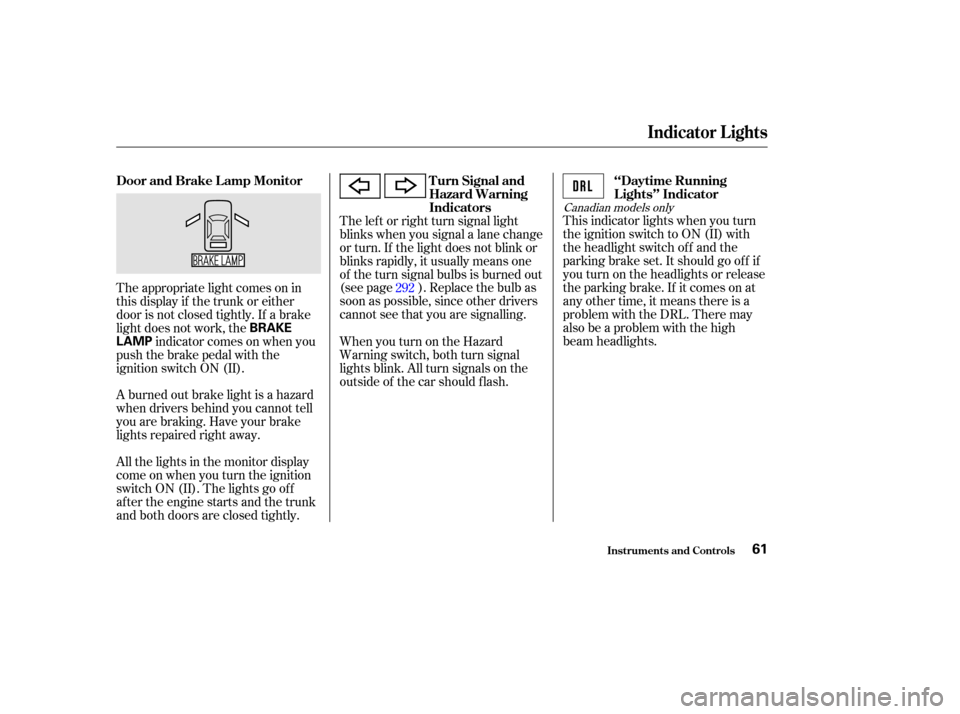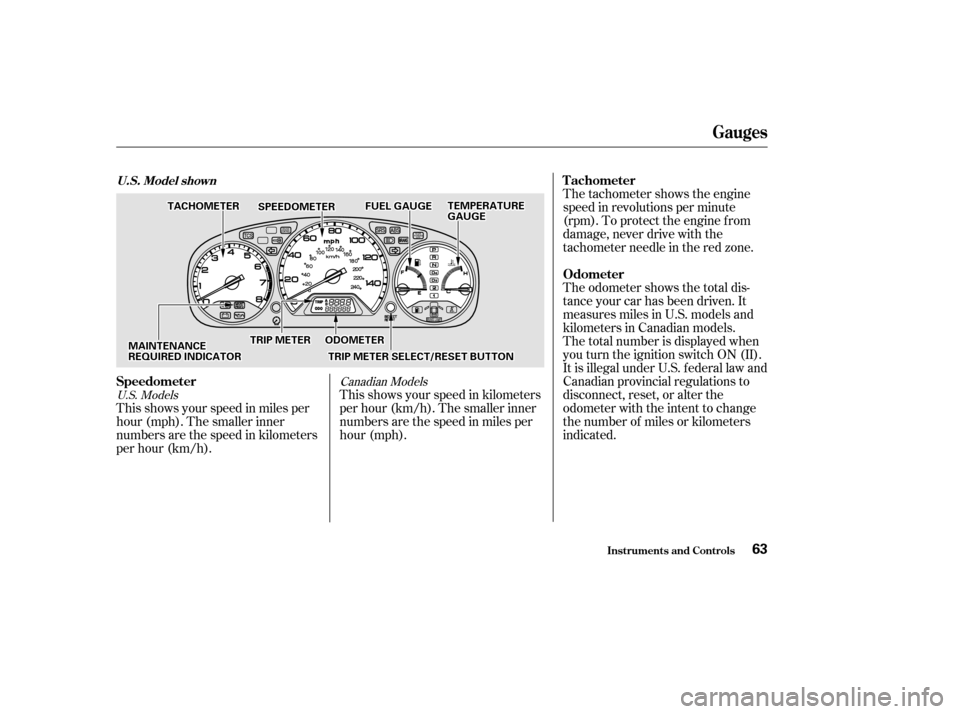engine HONDA ACCORD COUPE 2002 CL7 / 7.G Owners Manual
[x] Cancel search | Manufacturer: HONDA, Model Year: 2002, Model line: ACCORD COUPE, Model: HONDA ACCORD COUPE 2002 CL7 / 7.GPages: 375, PDF Size: 4.89 MB
Page 1 of 375

2002 Accord Coupe Online Reference Owner's Manual Use these links (and links throughout this manual) to navigate through this reference.
For a printed owner's manual, click on authorized manuals or go to www.helminc.com.
Contents
Owner's Identification Form
Introduction ........................................................................\
............................................................................. i
A Few Words About Safety ........................................................................\
.................................................. ii
Your Car at a Glance ........................................................................\
.............................................................. 2
Driver and Passenger Safety ........................................................................\
............................................... 5
Proper use and care of your car's seat belts, and Supplemental Restraint System.
Instruments and Controls ........................................................................\
................................................... 55
Instrument panel indicator and gauge, and how to use dashboard and steering column controls.
Comfort and Convenience Features ........................................................................\
............................... 107
How to operate the climate control system, the audio system, and other convenience features.
Before Driving ........................................................................\
..................................................................... 191
What gasoline to use, how to break-in your new car, and how to load luggage and other cargo.
Driving ........................................................................\
................................................................................... 205
The proper way to start the engine, shift the tr ansmission, and park, plus towing a trailer.
Maintenance ........................................................................\
......................................................................... 233
The Maintenance Schedule shows you when you need to take your car to the dealer.
Appearance Care ........................................................................\
................................................................. 303
Tips on cleaning and protecting your car. Things to look for if your car ever needs body repairs.
Taking Care of the Unexpected ........................................................................\
....................................... 311
This section covers several problems motorists someti mes experience, and how to handle them.
Technical Information ........................................................................\
....................................................... 341
ID numbers, dimensions, capaciti es, and technical information.
Warranty and Customer Relations (U.S. and Canada) ......................................................................357
A summary of the warranties covering your new Honda, and how to contact us.
Authorized Manuals (U.S. only) ........................................................................\
....................................... 361
How to order manuals and other technical literature.
Index ........................................................................\
......................................................................................... I
Service Information Summary
A summary of information you need wh en you pull up to the fuel pump.
Page 20 of 375

In addition, an occupant who is out of
position in the f ront seat can be
seriously or f atally injured by
striking interior parts of the car, or
by being struck by an inf lating f ront
airbag. Being struck by an inflating
side airbag can result in possibly
serious injuries.
After all occupants have adjusted
their seats and put on seat belts, it is
very important that they continue to
sit upright, well back in their seats,
with their feet on the floor, until the
car is parked and the engine is of f .
Sitting improperly can increase the
chance of injury during a crash. For
example, if an occupant slouches,
lies down, turns sideways, sits
forward, leans forward or sideways,
or puts one or both f eet up, the
chance of injury during a crash is
greatly increased.
Adjust the steering wheel, if needed,
so that the wheel points toward your
chest, not toward your f ace.
Pointing the steering wheel toward
your chest provides optimal
protection f rom the airbag.
See page f or how to adjust the
steering wheel.
73
CONT INUED
Driver and Passenger Saf ety
Maintain a Proper Sitting
Position
A djust the Steering Wheel 7.
6.
Protecting Adults
17
Sitting improperly or out of
position can result in serious
injury or death in a crash.
Always sit upright, well back in
the seat, with your feet on the
floor.
Page 51 of 375

If the SRS indicator light does not
come on after you turn the ignition
ON (II).
If the light stays on after the
engine starts.
If the light comes on or f lashes on
andoff whileyoudrive.
The SRS indicator light
alerts you to a potential
problem with your f ront airbags.
This light will also alert you to a
potential problem with your
automatic seat belt tensioners (page ). If the light comes on at any other
time, or does not come on at all, you
should have the system checked by
your dealer. For example:
If you see any of these indications,
your f ront or side airbags may not
deploy, your passenger’s side airbag
automatic cut-off system may not
work properly, or your seat belt
tensioners may not work when you
need them. See your Honda dealer
as soon as possible.
On models with side airbags, this
light will also alert you to a potential
problem with your side airbags or
passenger’s side airbag automatic
cut-off system (see page ).
When you turn the ignition ON (II),
this indicator will light brief ly then
go out. This tells you that the system
is working properly.
43
49
How the SRS Indicator L ight
Works
Additional Inf ormation About Your Airbags
Driver and Passenger Saf ety48
Ignoring the SRS indicator light
can result in serious injury or
death if the airbags, cut-off
system, or tensioners do not
work properly.
Have your vehicle checked by a
dealer as soon as possible if
the SRS light alerts you to a
potential problem.
Page 55 of 375

High levels of carbon monoxide can
collect rapidly in enclosed areas,
such as a garage. Do not run the
engine with the garage door closed.
Even with the door open, run the
engine only long enough to move the
vehicle out of the garage.Select the Fresh Air mode.
Select the mode.
Turn the f an on high speed.
Set the temperature control to a
comfortable setting.
Your car’s exhaust contains carbon
monoxide gas. You should have no
problem with carbon monoxide
entering the car in normal driving if
you maintain your car properly.
Have the exhaust system inspected
f or leaks whenever:
The car is raised f or an oil change.
You notice a change in the sound
of the exhaust.
Thecarwasinanaccidentthat
may have damaged the underside. With the trunk lid open, air f low can
pull exhaust gas into your car’s
interior and create a hazardous
condition. If you must drive with the
trunk lid open, open all the windows
and set the heating and cooling
system/climate control system as
shown below.
If you must sit in your parked car,
even in an unconf ined area, with the
engine running, adjust the heating
and cooling system/climate control
system as f ollows:
1.
2.
3.
4.
Carbon Monoxide Hazard
Driver and Passenger Saf ety52
Carbon monoxide gas is toxic.
Breathing it can cause
unconsciousness and even kill
you.
Avoid any enclosed areas or
activities that expose you to
carbon monoxide.
Page 61 of 375

The engine can be severely damaged
if this light f lashes or stays on when
the engine is running. For complete
inf ormation, see page .
If this light comes on when the
engine is running, the battery is not
being charged. For complete
inf ormation, see page .
This indicator lights when you turn
the ignition switch ON (II). It is a
reminder to you and your passengers
to protect yourselves by f astening
the seat belts. A beeper also sounds
if you have not fastened your seat
belt.
If you do not f asten your seat belt,
the beeper will stop af ter a f ew
seconds but the light stays on until
you do. Both the light and the beeper
stay of f if you f asten your seat belt
bef ore turning on the ignition.
The instrument panel has many
indicators to give you important
inf ormation about your car.
327
328
Indicator L ights
Inst rument s and Cont rols
L ow Oil Pressure
Indicator
Charging System
Indicator
Seat Belt Reminder L ight
58
Page 62 of 375

This indicator comes on f or a f ew
seconds when you turn the ignition
switch ON (II). It will then go of f if
you have inserted a properly-coded
ignition key. If it is not a properly-
coded key, the indicator will blink
and the engine will not start (see
page ).
This indicator also blinks several
times when you turn the ignition
switch f rom ON (II) to ACCESSORY
(I) or LOCK (0).
This light normally comes on f or a
f ew seconds when you turn the
ignition switch ON (II), and when
the ignition switch is turned to
START (III). If this light comes on at
any other time, there is a problem in
theABS.If thishappens,takethe
cartoyourdealertohaveitchecked.
With the light on, your car still has
normal braking ability but no anti-
lock. For complete inf ormation, see
page .
This light has two f unctions:
This indicator comes on when you
turn the ignition switch ON (II). It
is a reminder to check the parking
brake. Driving with the parking
brake not f ully released can
damage the brakes and tires.
If the indicator remains lit after
you have f ully released the
parking brake while the engine is
running, or if it comes on while
driving, it can indicate a problem
in the brake system. For complete
inf ormation, see page . See page .
1.
2.
75
332 219
329
Only on models equipped with ABS (see
page ) 200
Indicator L ights
Inst rument s and Cont rols
Immobilizer System
Indicator
Malf unction Indicator
Lamp
Anti-lock Brake System
(A BS) Indicator
Parking Brake and
Brake System Indicator
59
U.S. Canada
U.S. Canada
Page 63 of 375

This indicator has three f unctions:Itcomesonasareminderthatyou
have turned off the Traction
Control System.
It f lashes when the TCS is
regulating wheelspin.
If itcomesonandstaysonwhen
the Traction Control System is on,
it indicates that there is a problem
in the TCS.
This light also comes on when you
turn the ignition ON (II) and goes off
af ter the engine starts. See page f or more inf ormation on the
TCS. This indicator lights when you turn
the ignition switch ON (II). If it
comes on at any other time, it
indicates a potential problem with
your f ront airbags or automatic seat
belt tensioners. On models equipped
with side airbags, this light will also
alert you to a potential problem with
your side airbags or passenger’s side
airbag automatic cut-off system. For
complete inf ormation, see page .
This indicator lights when you turn
the ignition switch ON (II). If it
comes on at any other time, it
indicates that the passenger’s side
airbag has automatically shut off.
For complete inf ormation, see page
.
1.
2.
3.
49
48
220
Only on models equipped with side airbags
On all V6 models
Supplemental Restraint
System Indicator
Traction Control System
(T CS) Indicator Side A irbag Cut-of f
Indicator
Indicator L ights
Inst rument s and Cont rols60
Page 64 of 375

Canadian models only
This indicator lights when you turn
the ignition switch to ON (II) with
the headlight switch of f and the
parking brake set. It should go of f if
youturnontheheadlightsorrelease
the parking brake. If it comes on at
any other time, it means there is a
problem with the DRL. There may
also be a problem with the high
beam headlights.
The lef t or right turn signal light
blinks when you signal a lane change
or turn. If the light does not blink or
blinks rapidly, it usually means one
of the turn signal bulbs is burned out
(see page ). Replace the bulb as
soon as possible, since other drivers
cannot see that you are signalling.
A burned out brake light is a hazard
when drivers behind you cannot tell
you are braking. Have your brake
lights repaired right away. The appropriate light comes on in
this display if the trunk or either
door is not closed tightly. If a brake
light does not work, the indicator comes on when you
push the brake pedal with the
ignition switch ON (II).
All the lights in the monitor display
come on when you turn the ignition
switch ON (II). The lights go of f
af ter the engine starts and the trunk
and both doors are closed tightly. WhenyouturnontheHazard
Warning switch, both turn signal
lights blink. All turn signals on the
outside of the car should f lash.
292 ‘‘Daytime Running
Lights’’ Indicator
Turn Signal and
Hazard Warning
Indicators
Door and Brake L amp Monitor
Indicator L ights
Inst rument s and Cont rols61
BRAKE
LAMP
Page 66 of 375

This shows your speed in miles per
hour (mph). The smaller inner
numbers are the speed in kilometers
per hour (km/h).The tachometer shows the engine
speed in revolutions per minute
(rpm). To protect the engine f rom
damage, never drive with the
tachometer needle in the red zone.
The odometer shows the total dis-
tance your car has been driven. It
measures miles in U.S. models and
kilometers in Canadian models.
The total number is displayed when
you turn the ignition switch ON (II).
It is illegal under U.S. f ederal law and
Canadian provincial regulations to
disconnect, reset, or alter the
odometer with the intent to change
the number of miles or kilometers
indicated.
This shows your speed in kilometers
per hour (km/h). The smaller inner
numbers are the speed in miles per
hour (mph).
U.S. Models
Canadian Models
Speedometer T achometer
Odometer
Gauges
Inst rument s and Cont rols
U.S. Model shown
63
S SP
PE
EE
ED
D O
OM M E
ET
TE
ER
R
M
M A
AI
INNT TE
EN
NA AN
NC CEE
R
RE EQ
QU UIIRRE ED
D I
INND DI
ICCA A T
TO
OR R T
T
E
EM
M P
PE
ER
RA A T
TU
UR REE
G
GA AU
UG GEE
T
T
A
A C
CHH O
OM M E
ET
TE
ER
R F
FUUE EL
L G
GAAU
UG GEE
T
T R
RI IPP M
M E
ET
TE
ER
R S
SEEL
LEE C
CT T/
/R
RE ES
SE ET
T B
BUUT TT
TO
ON N
T
T
R
RI IPP M
M E
ET
TE
ER
R O
ODDO
OM M E
ET
TE
ER
R
Page 67 of 375

4-cylinder models6-cylinder models
6-cylinder models
The gauge stays at the same f uel
level reading af ter you turn of f the
ignition. When you add f uel, the
gauge slowly changes to the new
readingafteryouturntheignition
switch back ON (II).
The needle returns to the bottom
after you turn off the ignition. The
gauge shows the f uel level reading
immediately af ter you turn the
ignition switch back ON (II). This shows how much f uel you have.
It is most accurate when the car is on
level ground. It may show slightly
more or less than the actual amount
whenyouaredrivingoncurvyor
hilly roads.
This meter shows the number of
miles (U.S.) or kilometers (Canada)
driven since you last reset it.
There are two trip meters: Trip A
and Trip B. Switch between these
displays by pressing the Select/
Reset button repeatedly. Each trip
meter works independently, so you
can keep track of two dif f erent
distances.
To reset a trip meter, display it, and
then press and hold the Select/Reset
button until the number resets to
‘‘0.0’’.
Both trip meters will reset if the car’s
battery goes dead or is disconnected. This shows the temperature of the
engine’s coolant. During normal
operation, the pointer should rise
from the bottom white mark to about
the middle of the gauge. In severe
driving conditions, such as very hot
weather or a long period of uphill
driving, the pointer may rise to near
the upper red mark. If it reaches the
red (Hot) mark, pull saf ely to the
side of the road. Turn to page f or
instructions and precautions on
checking the engine’s cooling
system.
324
Trip Meter
Temperature GaugeFuel Gauge
Gauges
Inst rument s and Cont rols64